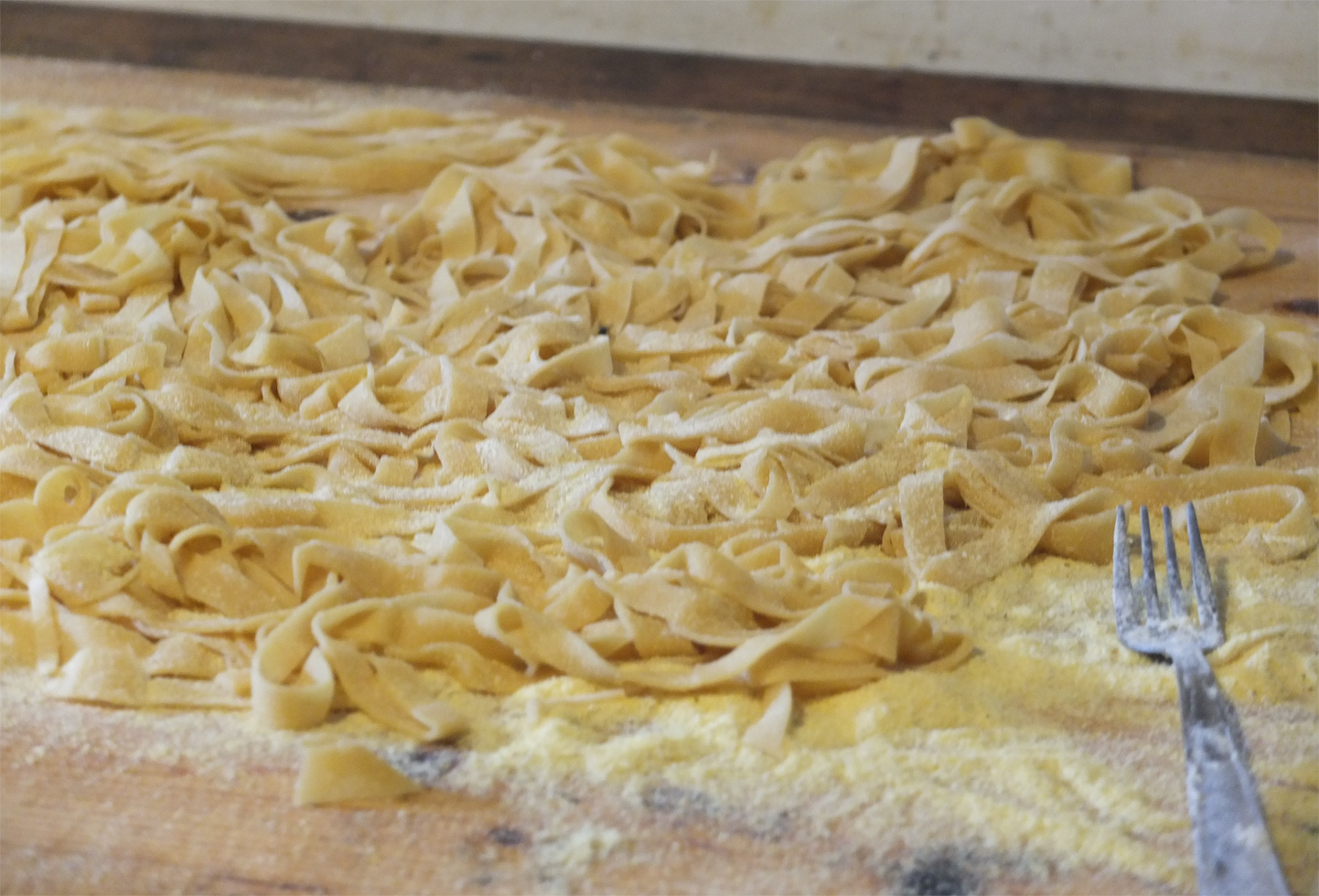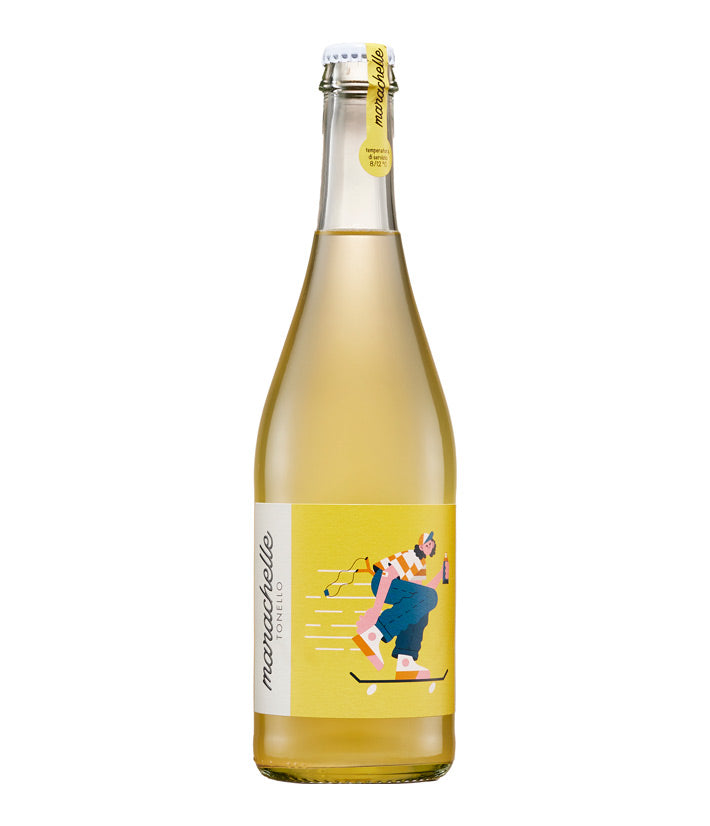
Tagliatelle al Ragù
Tagliatelle al ragù is an undisputed icon of Italian pasta cookery from the region of Emilia-Romagna, of which the city of Bologna is capital. A tomato-based meat sauce (ragù) is paired with thin ribbons of fresh egg pasta (tagliatelle). The dish is likely to have spurred the globally ubiquitous ‘spaghetti bolognese’, which non-Italians have incorrectly come to know as an Italian classic in its own right. Emilia-Romagna is the heartland of fresh egg pasta, and its people sneer at the idea that their famous meat sauce could be served with a ‘vulgar’ pasta like spaghetti. The dish is a simple one to prepare, presenting no real technical challenges for even the novice cook. Just remember to pay due attention to each step of the recipe; do not leave the house while the ragù is bubbling away or you might come back to find a pan of charcoaled sauce and a smoky kitchen. While there are many acceptable commercial egg pastas available, it is well worth making your own – the results will speak for themselves.
The following recipes are classics, to preserve their authenticity they need to be followed rigorously.
Fresh egg tagliatelle
Firstly, a word about equipment. All that is necessary is a wooden rolling pin, a large flat wooden board and a non-serrated knife. The wooden rolling pin and the wooden board serve to impart a roughness to the surface of the pasta, which helps the pasta absorb the sauce. A modern pasta machine and any flat surface, like marble or stainless steel, to roll the pasta on is shunned by purists, as they will render the surface of the pasta too flat for the sauce to cling to properly. If you are equipped with a modern pasta machine and have time constraints (it takes a bit longer to roll the pasta out by hand) do not be deterred, the results will still be good.
100 g ‘00’ flour
1 egg
a pinch of salt
These are the portions for one person, so multiply them according to how many people you wish to cook for. For practicality, it is best to prepare this recipe for a maximum of six people.
Place the flour on the wooden board in a mound and make a well in the middle. Gently break the egg(s) into the well and add a pinch of salt (a pinch for each egg). Using a fork, begin mixing the egg, gradually drawing in the flour as you mix. This should be done slowly and methodically. Once most of the flour has been incorporated with the egg, begin kneading the dough by hand. Use the palm of your hand to push the dough away from you, turning the dough after each push. After the first five or six pushes, gather the dough into a ball and continue to knead until it becomes smooth and elastic. At this point, the dough needs to be rested. If you’ve made the dough in advance, cover with cling film and rest in a cool place until needed. If you intend to cut the pasta straightaway, rest it for about 15 minutes in a cool place covered with a cotton cloth. Do not leave it much more than 15 minutes, otherwise the dough will dry out.
The rested pasta can then be rolled out. If using a pasta machine, simply follow the indications provided by the manufacturer. If adopting the traditional method, lightly flour the board and begin rolling the pasta, applying constant pressure – not too much, as you are not trying to squash the pasta – back and forth while rotating the pasta dough so as to maintain a circular form. This needs to be continued until you achieve a thickness of 1–1.5 mm, no more. When you have obtained your pale yellow disc of pasta, cover it with a cloth and allow it to dry slightly.
Roll the pasta up the way you would a Swiss roll. Cut slices of the pasta roll with a heavy knife. For authentic tagliatelle, in the style of Emilia Romagna, the slices should be a maximum of 8 mm wide, otherwise you will have pappardelle, which does not belong to the cooking of Emilia-Romagna. The cut pasta rings now need to be unravelled, after which they can be left to dry on a lightly floured surface, or even draped over a suspended stick or cane – a clean broomstick balanced between two surfaces will do the trick.
Ragù in the style of Emilia-Romagna
The following is a standard recipe of which there are many very subtle variants. A classic ragù in the tradition of Emilia-Romagna will be made from minced lean beef, a small addition of fattier minced pork, which will give a more luxuriant result, tomato sauce (passata di pomodoro) and a soffritto of celery, carrot and onion or shallot – garlic is never used. A soffritto is a fundamental building block in Italian cooking. It provides the foundation, adding depth and complexity of flavour to meat, fish and vegetable dishes. It is nothing more than a sauté of finely diced aromatic vegetables sautéed in extra-virgin olive oil until the vegetables soften and become aromatic. The carrots add sweetness to the slow-cooked meat, while the celery and onion contribute an earthy vegetable fragrance, as well as added complexity to the final dish. The ragù needs to bubble away slowly for at least two hours in order to cook through and meld the different ingredients into a complex whole. It needs to be stirred from time to time in order to prevent it from burning on the bottom, which causes bitterness in the sauce. In times long past, when gentry and nobles lived in spacious villas with detached guard houses, the preparation of the ragù was assigned to the guardians who resided in their guardhouses and watched over the comings and goings to and from the villa. As they had to stay put for long periods of time in order to fulfil their duties of surveillance, they had enough time to also watch over the cooking of the ragù, stirring it from time to time, ensuring that it wouldn’t burn.
The following quantities are sufficient to dress a quantity of tagliatelle made with 4 eggs and 400 g of flour.
2 tablespoons extra-virgin olive oil
80 g finely diced celery
70 g finely diced onion or shallot
60 g finely diced carrot
300 g lean minced beef
100 g minced pork (not too lean – the shoulder is fine, but belly is a little too fatty)
400 g tomato passata
salt and pepper
freshly grated Parmigiano Reggiano, to serve
Sauté the vegetables in the oil over medium heat until softened and fragrant but not caramelised. Add the meat and cook over high heat, making sure the meat is evenly browned. Add the passata and a little salt and bring to a simmer. Reduce the heat and simmer very gently for at least 2 hours, stirring from time to time, making sure the sauce doesn’t stick to the bottom of the pan. If the sauce becomes too dry during cooking, add enough water to ensure that at the end of cooking the sauce has a thick liquid consistency. After 2 hours, add salt if necessary and freshly ground pepper to taste. Cook for a further 15 minutes.
To cook the tagliatelle, use 1 litre of water for every 100 g of tagliatelle. Bring the water to the boil in a sufficiently large saucepan and add 10 g of salt per litre of water. Wait for the salt to dissolve and then add the tagliatelle, mix gently with a wooden spoon so that the pasta doesn’t stick – the tagliatelle need to sit separately in the boiling water to ensure an even and correct cooking. When the tagliatelle emerge from the boiling water and float to the surface, cook for another minute, then drain. It is wise to taste the tagliatelle as they cook to ensure they do not go beyond the point of al dente, otherwise all the hard work in preparing them will be in vain. Drain the tagliatelle and dress them in a large ceramic bowl with the ragù and grated Parmiggiano Reggiano cheese to taste.
And the wine? The ragù is a long slow-cooked preparation, and as such, richly flavoured and complex in taste. Served with tagliatelle, the rich, complex flavours are tempered. For this reason, a wine of medium body and tannin with good acidity to balance the richness of the ragù as well as the silky opulence of the egg-based pasta is needed. To stay local – usually a guarantee for success – a good choice would be a medium-bodied Sangiovese from Romagna, best with little oak influence. A lighter-style Chianti is another good option. For lovers of white wine, something with good body and acidity is needed; a mildly oaked Pecorino from Abruzzo or a mildly aged Fiano from Campania are good options.
Buon appetito.
- Category:
- Bologna,
- Emilia-Romagna,
- Food,
- Pasta
